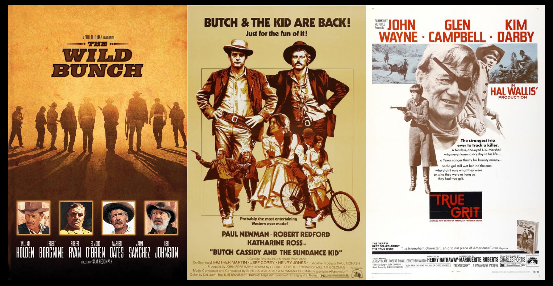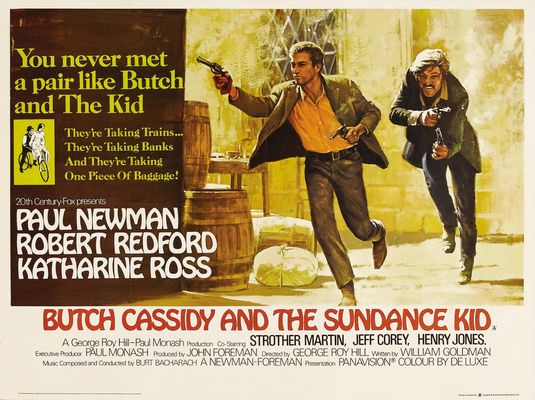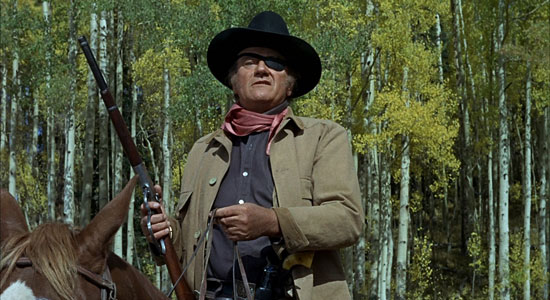This post Originally appeared on the defunct site "Fogs Movie Reviews" in the Fall of 2014.

The
western as a film genre went from being the most popular form of film
making in the early days of Hollywood, to one of the least seen forms of
story telling in contemporary times. Part of the reason was that
television drained the western of new ideas and stories. In 1959 there
were 26 western themed shows airing in prime time. Those are the days of
three networks and three hours a night. Today they have been replaced
by crime procedurals and reality shows. As the decade of the 1960s wore
on, the western film began to collapse. Sure there were successes and
and surprises but by the late seventies, only Clint Eastwood appeared
interested in fashioning films centered in the traditional American
Western period. Westerns rally every few years and achieve moments of
greatness or nostalgia. In the year 1969, three westerns managed to make
an artistic achievement, a populist surge and a satisfying trip down
memory lane. From the final year of the most turbulent decade in
American history, I want to share Three Movies I Want Everyone to See.


We
begin our journey with the most revolutionary of the Western films of
1969, "The Wild Bunch". This Sam Peckinpah splatterfest begins with a
robbery gone wrong. An entire small town gets shot to hell as a group of
bandits make their escape from a hired posse that had set them up.
Dozens are killed in the slow motion mayhem and the hired lawmen turn
out to be worse scum than the bad guys. The old ways are dying and old
loyalties die hard as well.

This
is a mediation on masculine values. What really makes a man a good
friend, when is the right time to fight, what sacrifices are you willing
to make, and how reckless can you be and still thrive? The story
focuses an a group of hardened men who are aging and still living life
as outcasts and criminals. They have each others back for the most part,
but sometimes they are capable of betrayal as well. "The Wild Bunch" is
filled with macho posturing and is frequently broken up by scenes of
hearty male laughter, signifying a grim but understood humor.
William
Holden stars as the leader of the bunch, Pike Bishop. The rest of his
gang consists of some of the great character actors of the 60s and 70s.
Ben Johnson and Earnest Borgnine go back to the 50s. Warren Oates is a
treasure that we should have had for a lot longer. Edmund O'Brien drops
in as a mentor/passive partner of the gang. The band of mercenaries
hired to get them is led by Pike's old friend and partner "Deke Thorton"
played by longtime movie vet Robert Ryan. He can barely tolerate the
low lifes that he has been given for the task and would much rather be
riding with his old cohorts. The two most recognizable vermin on his
crew are "Coffer" and "T.C." played by gritty western stalwarts Strother
Martin and L.Q. Jones.

A
big chunk of the plot of the movie was improvised after the first set
piece. It was pretty amazing that the train hijacking looks like it was
so well planned when it actually was designed on the day they shot it.
The violence in the film is straight Peckinpah, frequent, bloody and
often played back in slow motion. The inevitable conclusion of the film
brings galleons of fake blood to the set and an outcome that will
surprise no one given the lead up. These men are not willing to take the
easy way out when it is offered to them, especially when their peculiar
sense of loyalty and friendship is on the line.
Holden and
Borgnine form the nucleus of the film and their mediations on the
changing ways of the world hold the key to the point being made here.
Pike Bishop: What would you do in his place? He gave his word.
Dutch Engstrom: He gave his word to a railroad.
Pike Bishop: It's his word.
Dutch Engstrom: That ain't what counts! It's who you give it *to*!
The
final walk to the confrontation to rescue their captured friend is a
moment of macho swagger that was added at the last minute but has
survived for an eternity since then. If you think the line walking,
laid back attitude of the hoods in "Reservoir Dogs" is cool, take a look
at this image and remember that what follows was the most bloody and
controversial moment of violence ever shown in a mainstream film up to
that time.

Part
two of our post today is almost a mirror image of the story from "The
Wild Bunch". We still have two main outlaws who trade philosophical
dialogue, they are part of a dying breed and time, and they are pursued
by a relentless posse. In the reverse image however, the stars are not
hardened aging men but handsome young guys. The posse is not made up of
ragged scum but rather well trained professionals who are dedicated and
law abiding. Instead of masculine posing we get a light hearted
bromance with a dash of clever adventure thrown in.
 "
"Butch
Cassidy and the Sundance Kid" is an Academy Award winning script by the
talented and prolific William Goldman. It has the advantage of mostly
being true. The lives of the real outlaws were very much as depicted in
the film. The romantic interest played by Katherine Ross was a real but
unidentified woman and the "Whole in the Wall Gang" (in real life
referred to as The Wild Bunch) did exist and carried out robberies of
trains and banks across the west. The end of the story in real life took
place in Bolivia, just as it was located in the film.

Unlike
"The Wild Bunch", most of "Butch Cassidy" is charming rather than grim.
Butch appears to be able to talk himself out of having to resort to
violence most of the time. His cleverness becomes a running gag because
his plans often are fouled up despite how intelligent they seem to be.
He literally cannot believe that the posse can keep following them after
a half dozen tricks he uses to throw them off the track. The famous
scene of Newman and Redford jumping off the cliff is a result of
necessity when his ingenuity leaves Butch and Sundance with no
alternative.
There is a lot of humor in the film. As the
characters migrate to South America, they struggle with the language
differences and resort to using crib notes when holding up a bank. In
order to throw off pursuers, they take legitamate jobs as payroll guards
but are mocked by their employer for being so alert and trigger happy
before there is any payroll for them to guard. Strother Martin appears
once again, as the mining engineer Percy Garris, who hires the two to
watch his back in retrieving the payroll for the mining operation. His
character is also based on a real life acquaintance of the two outlaws.

The
chemistry between the two leads was so strong, and the work that they
did with director George Roy Hill so successful, that the three of them
teamed up again just a few years later for the Academy Best Picture of
1973 "The Sting". Hill also worked separately with each of the stars in
later films (including the greatest sports movie ever "Slap Shot").
When you hear the phrase "the whole is greater than the sum of it's
parts" it might be hard to believe about this movie since so many
elements were there to start with. Casting was right, the chemistry of
the actors was wonderful and the story is delightfully told, but small
touches and luck often elevate the film above its audience pleasing
front. The montage of photos showing the three principles stopping off
in New York before boarding a boat to South America, was created by
invention when the film makers were denied the ability to shoot on the
neighboring sets of "Hello Dolly". So the actors posed for still shots
on those sets and the photos were mixed with actual shots of New York at
the end of the 19th century.
There are a lot of modern film goers
who don't seem interested in westerns. This is the western made for
them. The plot is not based on a traditional showdown between the good
guys and the bad guys, there are no Indian sub-plots, and the movie is
funny as all get out. It is difficult to imagine a more mainstream film
that will satisfy non-traditionalists as much as this movie does.
If
you don't mind the traditional or the sentimental, then the last of our
1969 treats is a good way to finish up. Western fans all need to
acknowledge that the King of the genre was John Wayne. For nearly fifty
years, the Duke was the star of countless classic western adventure
stories. The list of his films includes the star making "Stagecoach",
the amazing and somber "The Searchers" , the deconstructionist "The Man
Who Shot Liberty Vallance" and the elegy "The Shootist". Wayne earned
his long overdue and only Academy Award for this Hal Wallis production.
Most of you have probably seen the
Coen Brothers version of "True Grit".
While the Coens dismiss the idea that their version is a re-make, it
has the same plot line and character arc from the book it is based on as
this one does. The difference is that their film is a lot less
sentimental and Rooster Cogburn is not nearly as charming, although he
still has grit. I love both versions of the film but being an old guy,
John Wayne is going to be my favorite.

There are several wonderful
scenes that have much of the same arcane dialect found in the Coen
film. There are also some amazing character actors in the film that
should be noticed. Robert Duvall was not a star at this point, and he
plays Ned Pepper as an ornery crook without much charm. His defiance of
the Marshall at the end leads to that great showdown on horseback that
everyone probably knows:
Ned Pepper: What's your intention? Do you think one on four is a dogfall?
Rooster Cogburn: I mean to kill you in one minute, Ned. Or see you hanged in Fort Smith at Judge Parker's convenience. Which'll it be?
Ned Pepper: I call that bold talk for a one-eyed fat man.
Rooster Cogburn: Fill your hands, you son of a bitch!

Jeff
Corey was a familiar face playing Tom Chaney, the man that Mattie Ross
is pursuing. He was a well known acting teacher in the Hollywood film
community. Also present in a small role was the unlikely Dennis Hopper.
He spent more than a decade playing small parts on film and television,
he even worked with Wayne once before on the "Sons of Katie Elder".
This film came out the same year he broke out with his directing and
starring triumph "Easy Rider". Talk
about a pair of opposing films. "True Grit" is a western from an old
studio and a producer who was legendary since the thirties. "Easy Rider"
was a rejection of almost all that was standard in film making and it's
loose narrative, freeform shooting style and heroic drug dealers were
the antithesis of just about every convention that this John Wayne
picture represents.
It is also fitting to note that once again,
Strother Martin appears in a 1969 western. This time he is Col.
Stonehill, the horse trading merchant that Mattie Ross trades barbs with
as she prepares to follow the two lawmen in pursuit of Tom Chaney.
Mattie Ross: Do you know a Marshal Rooster Cogburn?
Col. G. Stonehill:
Most people around here have heard of Rooster Cogburn and some people
live to regret it. I would not be surprised to learn that he's a
relative of yours.

Martin
completes this triple play of western roles with a third, completely
different characterization. He delivers the lines with exactly the tone
required to get that Charles Portis dialogue to crackle.
Late in
the picture John Fiedler shows up as Lawyer Dagget, a name Mattie has
bandied about like a Colt six shooter and he is nothing that anyone
would have expected. Looking at IMDB, it seems Wilfred Brimley has an
uncredited role in the film as well. One of the great joys in westerns
are the supporting performances that help make a story more interesting
and realistic. It is not always the Sheriff facing down the bad guy in
the last reel that makes the film work. All three of these films have
unconventional stories, great supporting performers and completely
different voices in describing the western experience. Whether you
prefer the gritty violence of "The Wild Bunch", the romantic nostalgia
of "Butch Cassidy and the Sundance Kid", or the sentimental traditional
western take of "True Grit", it was clear that 1969 was stocked full of
western movies that everyone should see.
Richard
Kirkham is a lifelong movie enthusiast from Southern California. While
embracing all genres of film making, he is especially moved to write
about and share his memories of movies from his formative years, the
glorious 1970s. His personal blog, featuring current film reviews as
well as his Summers of the 1970s movie project, can be found at
Kirkham A Movie A Day.















